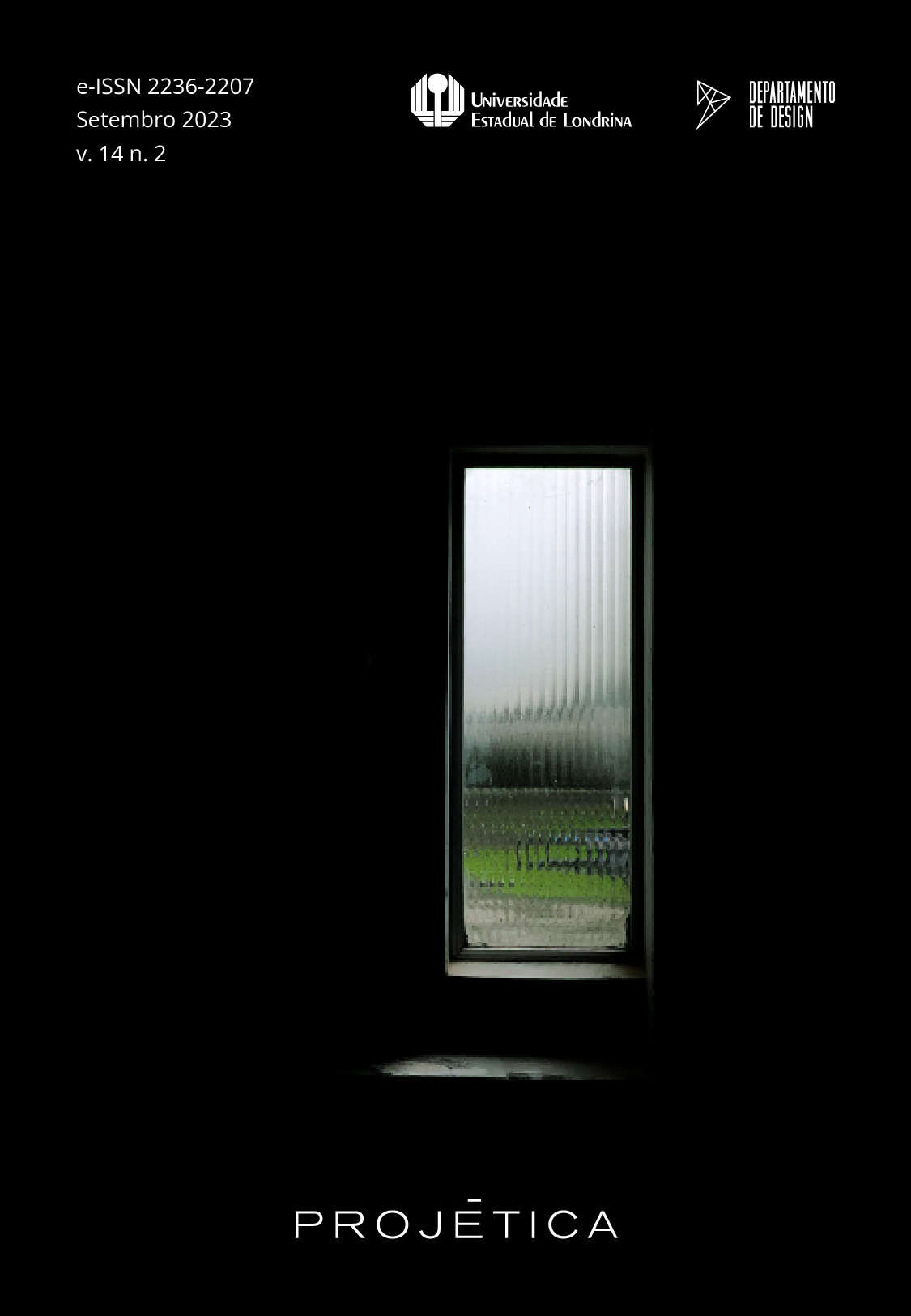The fuzzy front end off design and innovation processes
conceptualization spaces in traditional and contemporary productive contexts
DOI:
https://doi.org/10.5433/2236-2207.2023.v14.n2.46789Keywords:
fuzzy front end, innovation processes, systemic design managementAbstract
The activities that precede formal design and innovation processes are located in a space called fuzzy front end (FFE), understood as an ideal locus for the elaboration of new concepts. The aim of this article is to discuss spaces of conceptualization in these processes, considering the particularities of traditional and contemporary production contexts, as well as the strategic influence of design practices.
Downloads
References
ARCHER, Bruce. The Nature of Research. Co-design, v. 2, n.11, 1995.
BAXTER, Mike. Projeto de Produto: guia prático para o desenvolvimento de novos produtos. Tradução de Itiro Iida. 3. ed. São Paulo: Blucher, 2011.
BOEIJEN, Annemiek V. et al. Delft Design Guide: design strategies and methods. Amsterdam: BIS Publishers, 2013.
BROWN, Tim. Change by Design: how design thinking transforms organizations and inspires innovation. New York: Harper Collins, 2009.
CAUTELA, Cabirio; ZURLO, Francesco. Managing Five Tensions of the Design Process. Design Management Review, v. 22, n.3, p. 6-14, 2011. DOI: https://doi.org/10.1111/j.1948-7169.2011.00135.x
CHRISTIANSEN, John K.; GASPARIN, Marta. How Experiments in the Fuzzy Front End using Prototypes Generates New Options. CERN IdeaSquare Journal of Experimental Innovation, v. 1(1):35, p. 36-41, 2017.
COOPER, Rachel; PRESS, Mike. The Design Agenda: a guide to successful design management. Sussex: John Wiley & Sons, 1995.
COOPER, Robert G.; KLEINSCHMIDT, Elko J. Winning Businesses in Product Development: the critical success factors. Research-Technology Management, v. 50:3, p. 52-66, 2007. ISSN DOI: 10.1080/08956308.2007.11657441. DOI: https://doi.org/10.1080/08956308.2007.11657441
COOPER, Robert G. Winning at New Products. 3ed. Cambridge: Basic Books, 2001.
CROSS, Nigel. Design Thinking: understanding how designers think and work. New York: Berg Publishers, 2011. DOI: https://doi.org/10.5040/9781474293884
CROSS, Nigel. Engineering Design Methods: strategies for product design. 4th. ed. Sussex: John Wiley & Sons, 2008.
CROSS, Nigel. The Coming of Post-Industrial Design. Design Studies, v.2, 1981. p.3-7 DOI: https://doi.org/10.1016/0142-694X(81)90023-5
DARKE, Jane. The Primary Generator and The Design Process. Design Studies, v. 1, n.1, p. 36-44, 1979. DOI: https://doi.org/10.1016/0142-694X(79)90027-9
DESIGN COUNCIL. Eleven Lessons: managing design in eleven global companies. Desk Research Report. Design Council. London, p. 1-18. 2007.
DORST, Kees; CROSS, Nigel. Creativity in the design process: co-evolution of problem-solution. Design Studies, v. 22, n.5, p. 427-437, 2001. DOI: https://doi.org/10.1016/S0142-694X(01)00009-6
DUMAS, Angela; MINTZBERG, Henry. Managing the Form, Function and Fit of Design. Design Management Journal, v. 2, n. 3, 1991. 25-31. DOI: https://doi.org/10.1111/j.1948-7169.1991.tb00573.x
ESSLINGER, Hartmut. A Fine Line: how design strategies are shaping the future of business. San Francisco: Wiley, 2009.
GERSHENFELD, Neil. How to Make Almost Anything: the digital fabrication revolution. Foreign Affairs, v. 91, n. 6, p. 43-57, 2012.
HOPKINSON, Neil; HAGUE, Richard; DICKENS, Philip M. (Eds.). Rapid Manufacturing: an industrial revolution for the digital age. Sussex: John Wiley & Sons, 2006. DOI: https://doi.org/10.1002/0470033991
IMBESI, Lorenzo. Design Comes Out of Industry: new critical approaches for design in the economy of post-production. Crossing Talents! Cumulus Conference. Aalto University. Helsinki: [s.n.]. 2012. p. 36-43.
KOEN, Peter et al. Fuzzy Front End: effective methods, tools, and techniques. In: PDMA The PDMA Toolbook for New Product Development. New York: John Wiley & Sons, 2002. p. 5-35.
KOEN, Peter. The Fuzzy Front End for Incremental, Platform, and Breakthrough Products. In: PDMA The PDMA Handbook of New Product Development. New York: John Wiley & Sons, 2005. p. 81-91. DOI: https://doi.org/10.1002/9780470172483.ch6
KRIPPENDORFF, Klaus. The Semantic Turn: a new foundation for design. Boca Raton: CRC Press - Taylor & Francis Group, 2006.
KUMAR, VIJAY. 101 Design Methods: a structured approach for driving innovation in your organization. Hoboken: John Wiley & Sons, 2013.
LAWSON, Bryan. How Designers Think: the designers process demystified. 4. ed. Oxford: Architectural Press, 2005. DOI: https://doi.org/10.4324/9780080454979
LAWSON, Bryan. What Designers Know. Oxford: Architectural Press, 2004.
MAFFEI, Stefano; BIANCHINI, Massimo. Emerging Production Models: a design business perspective. In: JUNGINGER, S.; FAUST, J. Designing Business and Management. London: Bloomsbury Academic, 2016. p. 129-146. DOI: https://doi.org/10.5040/9781474243551.ch-010
MINEIRO, Érico F. Experimentação em Design como Estratégia no Cenário da Autoprodução. Tese (Doutorado em Design) - Pontifícia Universidade Católica do Rio de Janeiro. Rio de Janeiro, p. 201. 2016.
MINEIRO, Érico F. Integração de Gestão do Desenvolvimento de Produtos e Gestão do Design em Empresas Nascentes de Base Tecnológica. Dissertação (Mestrado em Engenharia de Produção) - UFMG. Belo Horizonte, p. 164. 2011.
MINEIRO, Érico; MAGALHÃES, Claudio. Da Fabricação Digital para o Design: propriedades emergentes e implicações. 13º Congresso Brasileiro de Pesquisa e Desenvolvimento em Design. Blucher Design Proceedings. Joinville: Blucher. 2018. p. 4801-4813. DOI: https://doi.org/10.5151/ped2018-6.1_ACO_02
MINTZBERG, Henry et al. O Processo da Estratégia: conceitos, contextos e casos selecionados. 4. ed. Porto Alegre: Bookman, 2006.
MOZOTA, Brigitte Borja. Design Management: using design to build brand value and corporate innovation. New York: Allworth Press, 2003.
PDMA - PRODUCT DEVELOPMENT MANAGEMENT ASSOCIATION. The PDMA Handbook of New Product Development. 2nd. ed. Hoboken: John Wiley & Sons, 2005.
REGNÉR, Patrick. Strategy-as-Practice and Dynamic Capabilities: steps towards a dynamic view of strategy. Human Relations, v. 61, n.4, p. 565-588, 2008. DOI: https://doi.org/10.1177/0018726708091020
ROZENFELD, Henrique et al. Gestão de Desenvolvimento de Produtos. São Paulo: Saraiva, 2006.
SANDERS, Elizabeth B. N.; STAPPERS, Pieter J. Probes, Toolkits and Prototypes: three approaches to making in codesigning. CoDesign, v. 10:1, p. 5-14, 2014. ISSN DOI: 10.1080/15710882.2014.888183. DOI: https://doi.org/10.1080/15710882.2014.888183
SCARPITTI, Chiara. Self-productions: a speculative approach. Strategic Design Research Journal, v. 9, n.1, p. 45-50, 2016. DOI: https://doi.org/10.4013/sdrj.2016.91.05
SCHÖN, Donald. Designing as a Reflective Conversation with the Materials of a Design Situation. Research in Engineering Design, v. 3, p. 131-147, 1992. DOI: https://doi.org/10.1007/BF01580516
TAVARES, Thayane S.; MAGALHÃES, Claudio. New Technologies Shift in Jewelry Design: from traditional optimization to contemporary speculation. Global Fashion Conference. Lyon, 2020.
TIDD, Joe; BESSANT, John; PAVITT, Keith. Gestão da Inovação. Porto Alegre: Bookman, 2008.
THOMKE, Stefan. Managing Product and Service Development: text and cases. New York: McGraw-Hill, 2007.
Downloads
Published
How to Cite
Issue
Section
License
Copyright (c) 2023 Érico Mineiro, Claudio Magalhães

This work is licensed under a Creative Commons Attribution 4.0 International License.
Projética está licenciada sob a Creative Commons Attribution CC-BY 4.0 International. Os autores detém os direitos autorais e concedem à revista o direito de exclusividade de primeira publicação.
Os autores dos trabalhos aprovados autorizam Projética a, após a publicação, ceder seu conteúdo para reprodução em indexadores de conteúdo, bibliotecas virtuais e similares.
Os autores assumem que os textos submetidos à publicação são de sua criação original, responsabilizando-se inteiramente por seu conteúdo em caso de eventual impugnação por parte de terceiros. As opiniões emitidas pelos autores dos artigos são de sua exclusiva responsabilidade.
A revista se reserva o direito de efetuar, nos originais, alterações de ordem normativa, ortográfica e gramatical, com vistas a manter o padrão culto da língua e a credibilidade do veículo. Respeitará, no entanto, o estilo de escrever dos autores. Alterações, correções ou sugestões de ordem conceitual serão encaminhadas aos autores, quando necessário. Nesses casos, os artigos, depois de adequados, deverão ser submetidos a nova apreciação. As provas finais não serão encaminhadas aos autores.











